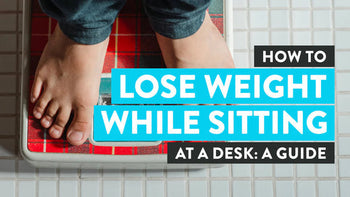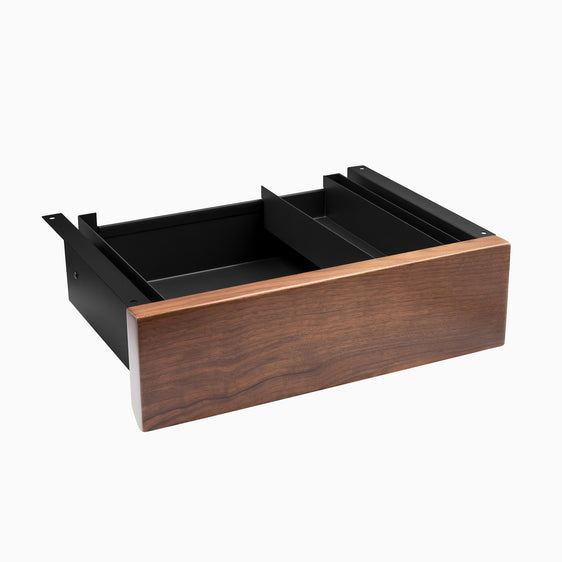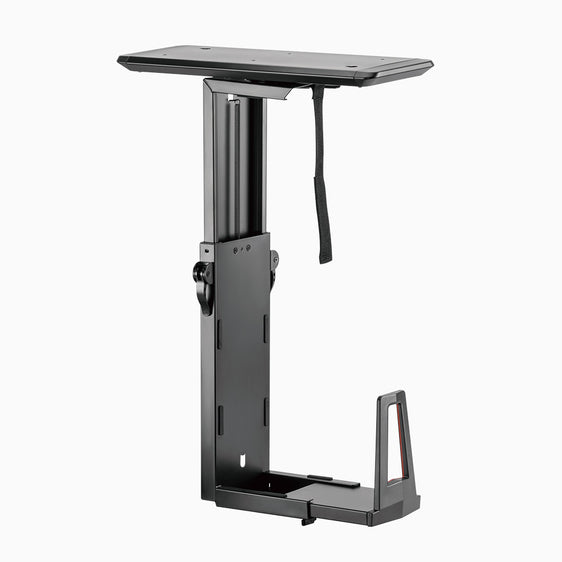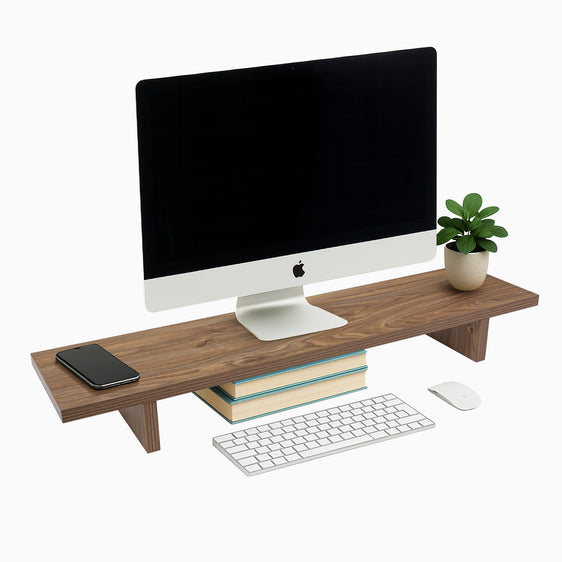
News
How to Lose Weight While Sitting at a Desk: A Guide
Hayden AdamsBalancing your health and job can be challenging, especially with how packed your schedule can get.
However, losing weight and staying healthy isn't always about reaching a certain number of steps or going to the gym.
You can easily slip in minor changes to your daily routine that can improve your health, strengthen your joints, and even reduce anxiety.
Here's how you can lose weight at your desk job.
How to Lose Weight While Sitting at a Desk

Calorie burn and exercises at your desk to lose weight aren't always about lifting weights or running on a treadmill. You can efficiently work on your body while sitting at your desk.
Here are some things you can do to lose weight and add physical activity to your typically-sedentary workday.
Incorporate Deskercises
Exercise doesn't just help you lose weight. It also prevents diabetes, cardiovascular disease, and other lifestyle illnesses.
The best part is that you can actually get a full-body workout throughout the day without leaving your work desk.
Here are a few ways to sneak a workout in without having to move from where you sit or stand at work.
Leg Lifts
You can easily tone your leg muscles while sitting in the office by sneaking in leg lifts. It's one of the most straightforward exercises you can do while sitting at a desk.
Extend your leg until it's at level with your hips. Then, slowly lower them. Repeat around 10 to 15 times before you switch legs.
If you find this effective, you can also look into toe raises for a more subtle workout. How many calories do you burn sitting while doing this will depend on how long you can do it.
Seated Marching
You don't need to be standing to march and get your legs moving.
Sit up straight and have your feet flat on the ground. Keep your trunk upright while you lift one knee. Hold it for a few seconds before lowering it back down.
You should feel the muscles in front of your hips doing most of the work.
Chair Swivels
Chairs that twist serve as a great way to slip into office exercises to lose weight while you sit at your desk.
Sit upright and lift your feet off the ground. Then, hold onto your desk with your fingers, but not too tight, so your arms don't do all the work. Use your abdominal muscles to get your chair swivelling.
You know you're doing the exercise right if you feel tightness in a vertical line from your belly button to your breastbone.
Make Healthier Food Choices

The famous saying "You are what you eat" couldn't be more accurate. Sitting around all day in front of your desk makes it possible to get bored and munch on unhealthy snacks.
Your eating habits significantly affect your caloric intake.
Here's how to shift your diet and prevent belly fat from forming after a hard day's work.
Opt For Nutritious Snacks
Stocking up your desk drawer with junk food and sweets might sound tempting, especially if it gets you going when you're bored. However, it's an extremely unhealthy habit that can spoil your lunch.
Try to stock up on healthy snacks in your desk drawer, such as trail mix or pre-portioned nut packs. You can also share fruit and vegetable slices in your office fridge.
Watch Portion Sizes
Dieting isn't always about cutting whole food groups from your meals. The more you avoid these cravings, the more food you might eat. It can actually be another cause of weight gain.
Knowing your limits is the best way to better deal with food and dieting. Eat what you're craving, but portion it properly.
If you're craving pasta or bread, you can give in to your carbohydrate cravings, provided you don't overindulge.
You might need the sugar, and incorporating it properly in your meal and balancing it with other food groups is the way to go.
Stay Hydrated
Just because diet soda has the word diet in it doesn't mean it's an excellent way to hydrate your body.
Drinking water is a great way to cleanse your body, avoid dehydration, and stay in shape.
Your trips to the pantry for a refill or to the restroom are also great ways to boost your step count and keep your metabolism going.
If you're bored of plain water, you can infuse herbs and fruits to give it more flavour. There are plenty of recipes online from experts like the Nutrition Twins, who can give you great ideas.
You can also mix green tea and other similar drinks to help burn calories.
Modify Your Work Environment
Working in front of a desk all day can cause many sitting problems, affecting your fitness and overall productivity.
Here's how you can modify your environment to improve your general health.
Use a Standing Desk
You don't have to spend your day sitting if your workplace has a standing desk to keep you on your feet. It's a different way to get productive, even if you stand for just an hour daily.
Research shows that standing can help you lose more calories compared to sitting.
{{ spec_single_sit_stand }}
Swap your Chair for a Stability Ball or a Kneeling Chair
Instead of sitting on your regular office chair, you can try sitting on a balance ball while you work.
Using a kneeling chair can provide an active body movement and promote a healthier posture, all while you enjoy yourself without even realising it.
Either can help strengthen your core while you get productive in the office.
{{ spec_kneel_chair }}
Improve Your Posture
Good posture can work wonders for your productivity. It can help you feel more confident compared to slouching.
Sit straight with your shoulders back to engage more muscles while sitting.
Take Breaks for Movement
How many calories you can lose through non-exercise activity thermogenesis (NEAT) or doing everyday things will surprise you.
You can do these things throughout the day to spice up your work.
Walk During Phone Calls
Walking during your calls can be a great way to integrate moving into your routine if you're not restricted by a wire.
Walking can help you get a bit more movement compared to sitting in your chair the whole day.
Use the Stairs Instead of the Elevator
If you're going one floor up or down, using the stairs can help work up a bit of a sweat.
It's one of the best exercises to reduce belly fat while sitting in office, allowing you to turn your office's stairs into your gym equipment.
Set Reminders for Regular Movement Breaks
Sometimes, we hyperfocus on our tasks and forget to stretch and take a breather. We only realise how much we need it once our joints have gone stiff.
Setting a reminder can help you be more aware of the time and know when to move.
These can be set on phones, smartwatches, or fitness bands to remind you to take a break and get moving.
You can also use times, like your lunch break, to get out for some fresh air and get the most movement of the day.
Change Unhealthy Habits

Losing weight is more than just sweating and eating right. Other factors can affect how we approach fitness and wellness.
While leaning towards unhealthy habits might seem convenient and easy, it can cost you a lot in the long run.
Here are the many ways to let go of unhealthy activities that could stop you from maintaining good health.
Manage Workplace Stress
Stress is one of the main reasons why we snack too much or prevent ourselves from moving around.
You can try to plan your week better by creating to-do lists and planning your meals accordingly.
Sometimes, even laughing and breathing deeply can help you cope with your stress at work.
As long as you build awareness over what stresses you out and lean towards healthier coping mechanisms, you can have a better outlook on your work.
Prioritise Sleep
Sleeping is vital for weight loss and gain since it helps repair and rebuild fat-fighting lean muscles.
Sleeping also manages hunger-regulating hormones that can get you to eat more.
Utilise Proper Ergonomics
Ergonomics can easily change your attitude towards your work and move every day.
Maintain proper posture and adjust your workspace to make it more comfortable.
Benefits Of Standing Desks
Research into the efficacy of standing desks continues to reveal their numerous benefits.
Good for core
One notable advantage of standing desks resides in their ability to promote improved spinal alignment. When we stand, the abdominal muscles participate more actively, which assists in maintaining spinal alignment, thereby reducing the workload on our back and neck muscles.
Studies confirm that standing helps lower muscle tension, mainly because it requires less effort for our body to hold itself upright. This effortless engagement of the abdominal muscles eventually leads to a properly aligned spine, as pointed out by this PubMed research.
Chiropractor and physical therapist approved
There is no doubt that prolonged sitting can contribute to a multitude of musculoskeletal problems. Chiropractors, who specialise in the prevention, diagnosis, and treatment of these issues, regularly suggest the use of standing desks to their patients.
This is because maintaining a seated position for extended periods can lead to negative consequences such as back and neck pain, not to mention headaches.
Burning calories
Does the use of a standing desk support calorie-burning? If you're wondering, the answer is definitely yes.
Studies indicate that the act of standing can burn about 88 calories per hour, which, although slight, is incrementally higher than the 80 calories burned while sitting. This gives standing desks an edge in the battle against calorie accumulation.
Boosts mood in workplace
With a standing desk, workers can enjoy a significant boost in mood and energy levels. A seven-week study revealed that people who spent their day standing rather than sitting felt less stressed and exhausted.
Amazingly, the majority, a whopping 87%, confessed to experiencing increased vitality and improved productivity throughout the day. Efforts to stand more often can lead to improved overall well-being in the workplace.
Helps lose weight
Believe it or not, simply standing instead of sitting could contribute to weight loss. Research data from Harvard Medical School confirms that standing burns 0.15 calories more per minute than sitting. If you opt to stand for six hours a day, the additional calorie expenditure could sum up to 54 calories for a 143.3-pound adult.
Are Standing Desks Better For Your Health?
Although there is yet to be any clear evidence on the long term health benefits of the standing desk, this is simply because we haven’t been using sit-stand desks for long enough to know. However, numerous studies have indicated that the potential for these desks to improve public health is huge.
What we do know for sure is that our sedentary lifestyles are having a profound effect on our health and wellbeing. So anything we can do to cut down our sitting time and increase the hours a day we are active is a huge positive. And encouraging an active work life by installing standing desks has been shown to work.
Most of us spend over half of our waking lives at work, Monday to Friday at least. So changing our work style seems an obvious place to start to improve our health overall. For anyone concerned with their productivity, and their long term wellbeing, standing desks are well worth it.
Although there is yet to be any clear evidence on the long term health benefits of the standing desk, this is simply because we haven’t been using sit-stand desks for long enough to know. However, numerous studies have indicated that the potential for these desks to improve public health is huge.
What we do know for sure is that our sedentary lifestyles are having a profound effect on our health and wellbeing. So anything we can do to cut down our sitting time and increase the hours a day we are active is a huge positive. And encouraging an active work life by installing standing desks has been shown to work.
Most of us spend over half of our waking lives at work, Monday to Friday at least. So changing our work style seems an obvious place to start to improve our health overall. For anyone concerned with their productivity, and their long term wellbeing, standing desks are well worth it.
Can Sit Stand Desks Prevent Obesity and Heart Disease?
So do standing desks improve health noticeably? Unfortunately, the outcomes of many studies are unclear. Although there is a body of evidence that standing desks can help with back pain and in the fight against obesity, the small sample sizes and short time scale of the research conducted so far has struggled to find conclusive links that they can offset more serious problems. This was summarised in the Cochrane review of 2016, which sought to compile and analyse the data from 34 studies to find meaningful trends.
However, the study found compelling evidence that installing a sit stand desk increased standing time, and thus decreased sitting time in the work setting. Although there were definitely no adverse effects on health, the quality of evidence available and the sample size made drawing any real conclusions about the long term health benefits impossible.
A further review by The University Of Pittsburgh arrived at a similar conclusion. Although many studies had been carried out, the fact that nearly all participants were young and healthy made it impossible to draw conclusions, as problems such as heart disease disproportionately affect older workers.
And there are studies beginning to emerge which do seek to address these issues directly. An economic evaluation carried out by Deakin University perhaps carries the most promise. This study found that standing desks could have huge benefits if they were rolled out to 20% of the Australian workforce. The study also suggested that adopting this policy would reduce absenteeism, boost productivity, and in the long term save billions of dollars in healthcare.
And whether the benefits are proven conclusively or not, it appears that many key figures in business are not willing to wait for medical advice. Tim Cook of Apple personally revealed that all workers at the company’s new California headquarters had been given standing desks, describing sitting as “the new cancer”.
With larger and more comprehensive studies underway, it appears to an extent the jury is still out on the long term benefits of standing desks. However, the more recent results and studies, as well as the actions of business leaders, suggest that the standing desk will have real benefits in the fight against obesity and related illnesses.
What is not in doubt is that a more active lifestyle leads to less of these health issues. And the standing desk has been proven to make employees more active, with results showing that on average workers stood for an extra hour than they would have at a normal desk.
So even though the research into the long term effects is as yet inconclusive, all of the signs suggest that standing desks could be invaluable in the fight against obesity, heart disease and related health problems.
Frequently Asked Questions
You might have more questions about losing weight while sitting at your desk. We've gathered the most common ones to help you with your research.
Do standing desks help belly fat?
In anticipation of an easy fitness solution, many ask if standing desks serve as a form of exercise. Understanding the distinction between standing and more dynamic activities is crucial. It is important to keep in mind that standing desk exercises to lose weight does not equate to exercise in the conventional sense.
There is no concrete evidence to suggest that merely standing offers the same cardiovascular benefits as running or cycling. So, please remember, standing desks are not a substitute for regular exercise. A study provides further insight on this.
Does standing all day build muscle?
The notion that standing all day results in muscle building is commonly misconceived. Extended standing might increase the endurance of leg muscles, but this approach won't significantly impact muscle size or power.
Moreover, for the specific goal of leg muscle endurance, there are far more effective methods, such as walking or running.
Can I Really Lose Weight by Making Small Changes at Work?
Yes, minor adjustments and changes can pay off regarding weight loss, especially if you consistently follow through.
You don't need drastic changes to maintain a healthy lifestyle. It's all about developing healthy and manageable habits you can do daily.
How Much Exercise Should I Aim for Throughout the Workday?
It would be best to have an average of 60 minutes of moderate to vigorous workouts daily. You can easily slip this in with things you do every day, like commuting to work or taking the stairs.
What Are the Best Healthy Snack Options for the Office?
If you're looking for healthier snacks, it's best to avoid the vending machine and prepare them beforehand. Try stocking up on non-perishables, like trail mix, protein bars, and granola. They're great low-calorie snacks that can satisfy your occasional munchies at work.
It's also great to have fruit and vegetable slices in your office fridge, which you can grab whenever you're hungry between meals. Even if these snacks are healthier, you should still remember to portion everything you're eating and not spoil your appetite for your meals.
Is Using a Standing Desk Better for Weight Loss Than Sitting?
Studies from Harvard show little difference in the calories you burn between sitting and standing desks.
Sitting at your desk can help you burn around 80 calories an hour.
On the other hand, standing can help you burn a few extra calories of up to 88 calories per hour. Other activities you do while sitting or standing can also affect how many calories you burn in these positions. If you can incorporate more movement, you can burn more calories.
How Can I Make Better Food Choices at Work-Related Events?
Work-related events are a great time to reward yourself for working hard in the office. You'd want to enjoy the food and not restrict yourself. However, if there are healthy options on the menu, you can try incorporating that into your meal. Try to have a balance between carbs, protein, and vegetables.
Don't completely cut yourself off from treats like cake and pastries. That will only get you craving them more. Enjoy the foods they offer, but know your limits and only get what you can.
Conclusion
Balancing work, exercise, and diets can initially seem intimidating, especially with how busy your day can get. Try making these little changes in your routine and get moving whenever you can. It's a great way to stay on top of your game and live healthier.










